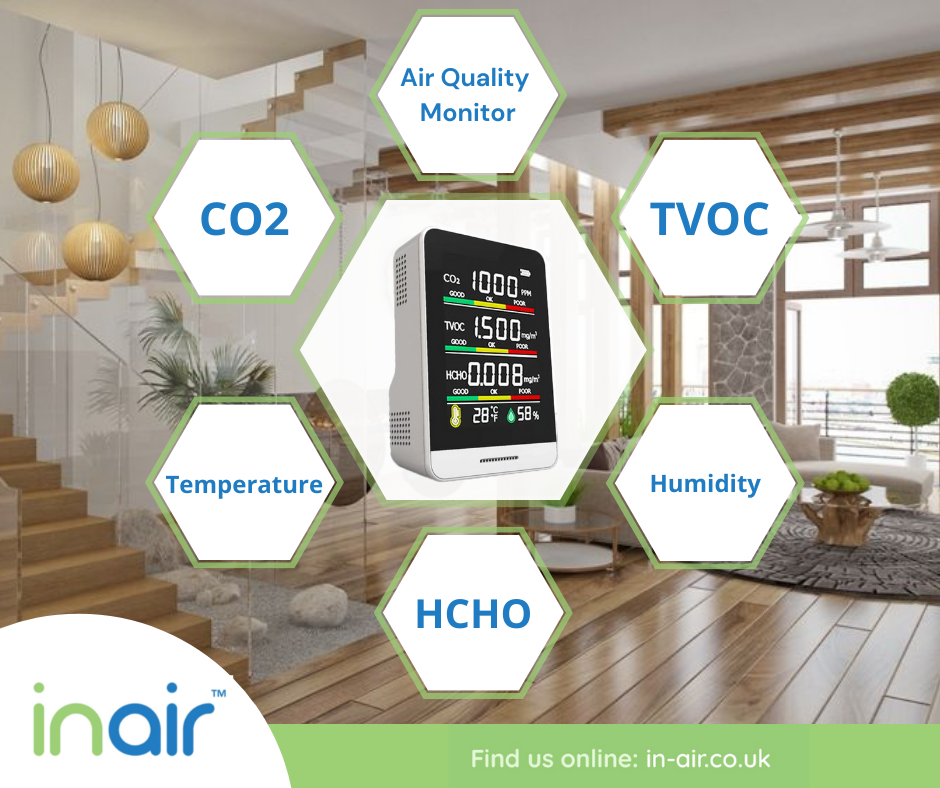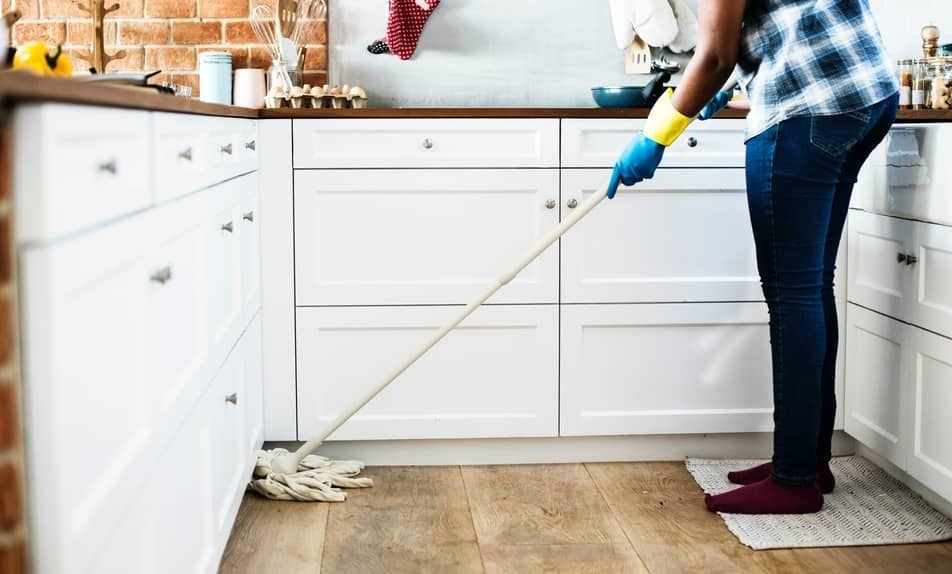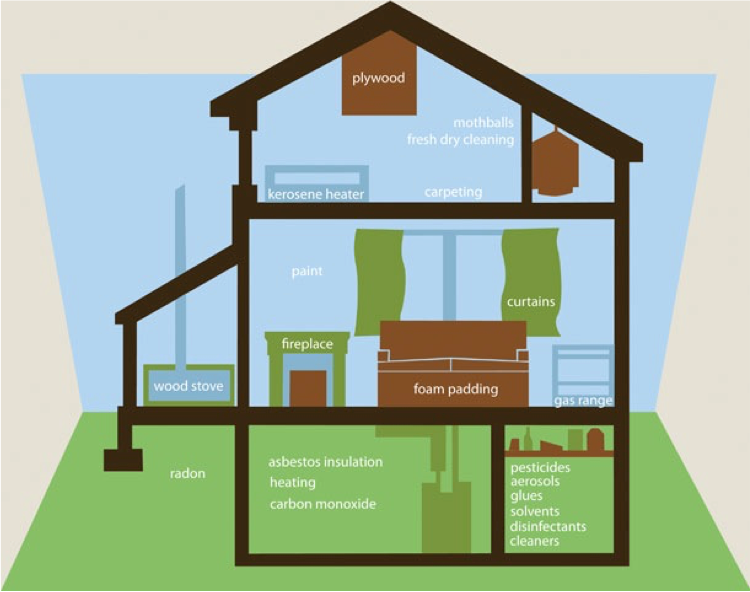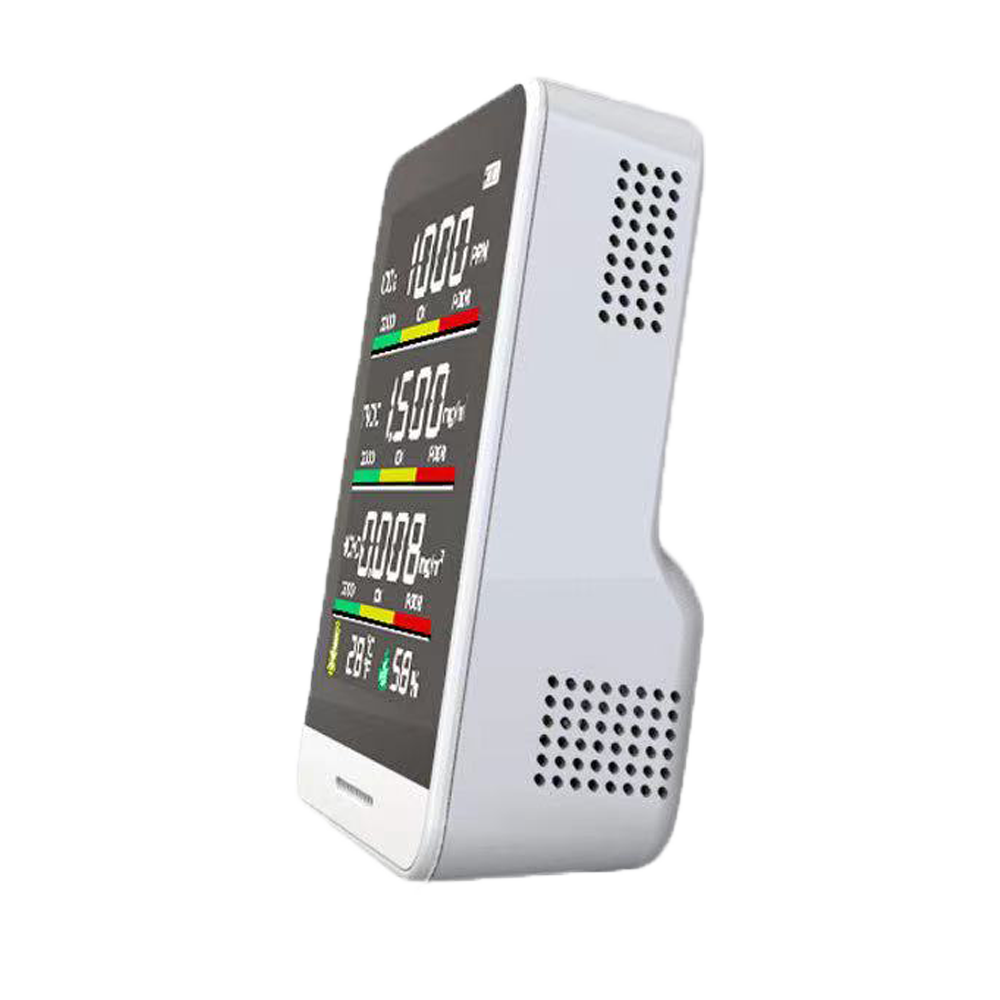
It is well known that outside air pollution can be harmful to our health, however less attention is paid to the indoor air where we spend 90% of our time. This time can be spent at home, school, work etc. and the air pollution can consist of dirt, dust, gas and other microparticles we may breathe in. Using our new Air Quality Monitor, you are able to track the levels of CO2, TVOC (Total Volatile Organic Compounds), HCHO (Formaldehyde) as well as the temperature and humidity in the room.
Although you normally hear of Carbon Dioxide (CO2) when discussing global warming, it is also a good indicator of the air quality inside your home (or another indoor environment.) CO2 is very rarely an issue to our health as it is emitted by all humans while breathing however over exposure can produce a variety of effects that may include headaches, dizziness, restlessness, pins or needles, breathing difficulties, sweating, tiredness and an increased heart rate. See our table below which indicates CO2 levels alongside the potential health hazards that coagulate.
CO2 (Carbon Dioxide) Levels
|
250-350 ppm (Parts Per Million) |
Normal outdoor air level. |
|
350-1000 ppm |
Typical level found in occupied spaces with good air exchange. |
|
1000-2000 ppm |
Level associated with complaints of drowsiness and poor air. Poor air quality could also relate to poor ventilation. |
|
2000-5000 ppm |
Level associated with headaches, sleepiness, stagnant air, poor concentration, loss of attention, increased heart rate and nausea. |
|
>5000 ppm |
This level would indicate unusual air conditions where high levels of other gases may also be present. Toxicity or oxygen deprivation could occur. |
|
>40,000 ppm |
This level is immediately harmful and will cause oxygen deprivation. |
In relation to health effects caused by a build-up of CO2, a high level can also raise indication that the aeriation in the room may need improvement. Though CO2 levels are not found to be a direct exposure to the coronavirus we are now all too familiar with, checking these levels daily can highlight poorly ventilated areas.
Our Air Quality Monitor measures the level of CO2 in whichever room it is placed, so you are able to check these levels throughout the day. If high levels are present, ventilation may be required to lower these readings. InAir™ are able to solve this issue with a range of Air Purifier and Ventilation systems, most notably the IA-450UV unit equipped with an 8-stage air cleaning system and known as the Virus Killer. Prioritising any areas for improvement reduces the risk of aerosol transmission which then in turn helps prevent contracting coronavirus.
The Monitor also allows you to view the TVOC levels in the room, and as the volatile organic components may be the least known factor in bad air quality, it is just as important to keep track of these readings.
TVOC is known as Total Volatile Organic Compounds which are found to be organic chemicals that become a gas when at room temperature. Some examples of this can be benzene, ethylene glycol, formaldehyde, methylene chloride, tetrachloroethylene and toluene. These types can be found in multiple sources inside your everyday environment such as:
- Household cleaners and disinfectants
- Pesticides
- Air fresheners
- Paints
- Solvents
- Glue
- New furniture and carpets

The effect of TVOC on your health will normally depend on the level of exposure. See our TVOC table below to gage an indication on which levels you should be aiming for daily. High levels will typically cause immediate symptoms which can occur once a person has been introduced to a particular exposure, for example a headache may appear after standing in a freshly painted room. Other symptoms (similar to the symptoms of CO2 exposure) can include dizziness, nausea, eye, nose and throat irritation, coordination loss, fatigue, skin reactions, stagnant air and in some cases cancer (this is particularly common in some VOCs like formaldehyde.)
TVOC Levels
|
Less than 0.3 mg/m3 |
Low level of concern. |
|
0.3 to 0.5 mg/m3 |
Acceptable level of concern. |
|
0.5 to 1 mg/m3 |
Borderline level of concern. |
|
1 to 3 mg/m3 |
High level of concern. |

Formaldehyde or what can also be known as HCHO, is a typical hazardous indoor air pollutant considered a carcinogen. HCHO is a colourless, flammable, strong smelling gas present all around us. It can be found in industrial emissions, cooking, smoking, traffic, and even building materials. In fact, a new study has shown that high levels of HCHO are typically found in new builds due to products such as treated wood, insulations containing TVOCs are used- in turn these products will give off the volatile organic compounds and evaporate into the air.
Due to the toxicity, HCHO exposure can cause health effects such as sore throats, an irritating cough, nausea, eye irritation, asthmatic attacks and as mentioned above, cancer. Exposure to this gas is a typical concern for children, elderly persons, pregnant women and those diagnosed with breathing problems. If exposed for long periods of time it likely someone would eventually develop a formaldehyde allergy, causing serious health defects- measuring HCHO levels is recommended daily to avoid this occurring.
Along with being able to monitor the CO2, TVOC and HCOC levels in your home, you are able to use our new device to measure the level of humidity and the temperature of the room.

As humidity is considered to be the main pollutant in homes, it is relevant to keep the indoor humidity level under observation. A high humidity level indoors can cause dust mites, mould and excess moisture in the air.
Not only is this bad for health, it can lead to rotting furniture, damaged flooring and peeling wallpaper/paint which isn’t great for your bank.
The good news is, if you happen to notice your humidity levels are increasing (as well as any other reading stated in this article) we also sell devices that will ventilate the room. Take our InAir Purifier IA-450UV unit for example, not only will this help with humidity levels (and CO2 levels previously mentioned), it removes any TVOCs, dust, dander and smoke from the atmosphere, purifying the air and making it easier to breathe.
With all this in mind, purchasing our Air Quality Monitor is a great way to keep track of all things important for either you and anyone else who shares the space the device is placed within.
For more information, or to view our other products visit our website www.in-air.co.uk.
